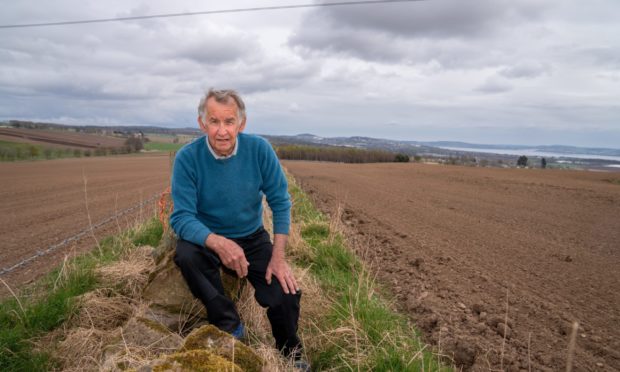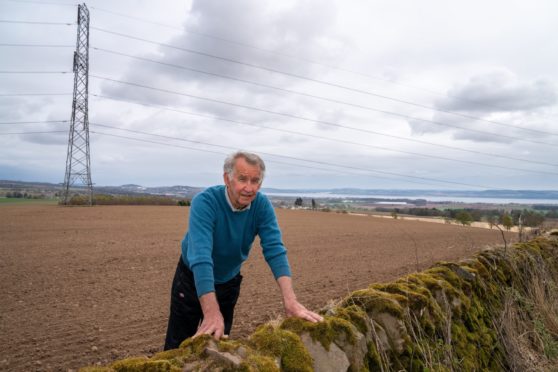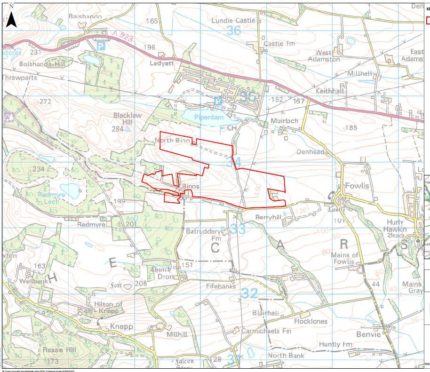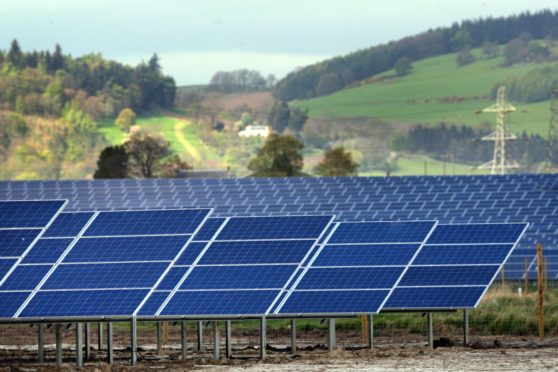Renewed plans to build one of the country’s biggest solar farms in Angus would see farmland the size of around 300 football pitches covered in panels for at least 35 years.
Renewable energy developers have begun the process of gaining planning permission for the giant solar farm on Berryhill Farm which, if approved, would consist of 152,000 individual panels reaching three metres high.
It is the third time farmer William Moncrieff has moved to put a solar farm on his land.
His plans have divided his neighbours across South Angus. One group has already formed in opposition. They have branded the “industrial” solar proposal “a travesty”.
But with Scotland’s progress on generating solar electricity stalling in recent years, developers argue the plan presents a huge opportunity for the local area and beyond.
For Berryhill Farm neighbour Doug Scott it is “not the right place” for a giant solar array.
He pointed out the land slated for development slopes up towards the peak of nearby Blacklaw Hill.
Solar farms should be flat and screened from view, he explained.
“Good idea, but not the right place.”
The retired customer service worker has lived in his bungalow next to the proposed development for 30 years.
“I don’t see how we’ll benefit. The electricity is generated during the day. Solar panels don’t work at night.
“I have solar panels on my roof and that’s where they should stay.
“That kind of power is generated during the summer months when everybody is outside. We’re not going to get the value of it because we only come into our houses at night.
“The people who are going to benefit from the summer electricity are the big users – the supermarket chains, the factories and the big shops.”
Solar farm near Dundee and the Perthshire border
The Berryhill arable farmland is around 700 metres to the north west of the village of Fowlis and to the immediate south of the award-winning Piperdam holiday complex.
Berryhill farmer William Moncrieff is working with developers Solar 2 after firm BP Lightsource walked away in 2019 after community consultation.
The farmer scrapped an initial proposal with Intelligent Alternatives in 2015.
It is understood the Muirhead, Birkhill and Liff Community Council would benefit from around £25,000 a year of community funding.
The final total would be around £1m over the projected lifetime of the project.
A spokeswoman said they had “yet to ascertain the views of the community” so did not yet have a position on the plans.
A group of local villagers, however, have joined up to fight the proposal.
A spokesman said the “the massive project would be a travesty”.
“This is not an industrial site. It is arable farmland that has been in more or less continuous use as such for many, many years.”
There is concern the site would be ringed with a fence and security cameras.
Approving the plan would “set a potentially extremely damaging precedent,” he added.
“Which could have a major bearing for the future of other arable land, not only in this area but across many other parts of the country for decades.”
Does Scotland need the green electricity?
The increase in electricity generated in Scotland from solar has slowed considerably after the UK Government temporarily removed the technology from the main subsidy scheme for supporting low carbon power.
Solar capacity grew from 2 megawatts (MW) to 326 MW in 2016 but stood at only 365 MW in March 2020, according to the Scottish Government.
The Berryhill proposal would add 50 MW – 13.7% of the 2020 total – to Scotland’s overall capacity.
The developer claims the solar farm will generate enough power for 12,5000 homes.
Walkers still welcome at Berryhill (solar) Farm
Farmer Mr Moncrieff said land use experts had given the land a low fertility rating in 2015.
He said: “Land doesn’t change much in five years so that will still be the case.
“In the western world, people are more likely to die of obesity than of starvation, so food growing is not an issue here.
“So I came to the conclusion that on balance the land would be put to better use for solar energy.”
Walkers will still be able to access Berryhill Farm despite the solar panels.
He said: “At the moment, a lot of people use my farm for walking and to get to Blacklaw Hill, during lockdown in particular.
“That is something I want to continue.
“I understand some people have concerns. But there is a lot of people in the local community who are in favour of it.
“If anyone has concerns about the plans, I am happy to talk to anyone. They know where I am so can come to the farm to talk.”
Giving the land a chance to recover?
Neil Lindsay, development director of Solar 2, said the plans provided the local area with a huge opportunity.
He defended any impact they might have on the area.
“The solar panels won’t really impact the ground, other than the poles, as the panels will sit over the ground to allow it to be grazed.
“What we’re doing will allow the land to recover.”
The green targets we’re being given mean we need to do better.”
Neil Lindsay, Solar 2
He said the new plans are commercially viable and do not rely on government subsidies.
“I don’t know for sure why the other bids failed. I do know that government subsidies were pulled at about that time so that may have had something to do with it.
“We have not included subsidies as part of our funding projections, so that would not be a factor for us.”
“The green targets we’re being given mean we need to do better. This project can play its small part in helping [meet them],” he added.



